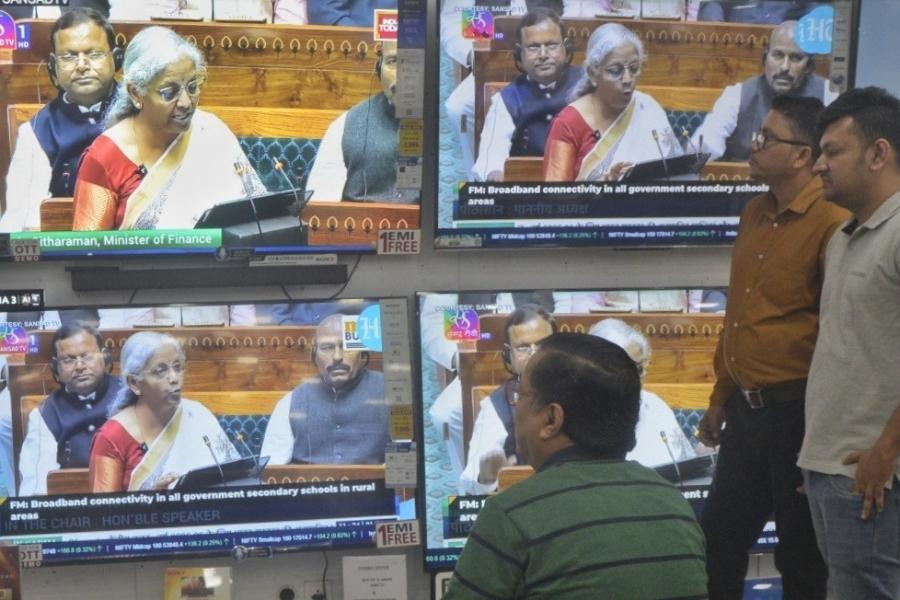The Union Budget 2025 has paved the way for a speedier green transition in the country, but failed to address the critical issue of climate adaptation finance that is vital to the lives and livelihoods of millions living in climate- vulnerable parts of the country like the Sunderbans, experts have said.
Climate adaptation finance is the process of providing financial resources to help people, businesses, and areas adapt to the effects of climate change and involves building resilience to physical risks such as flooding, drought, and other climate-related disasters. Sunderbans, with the country’s highest sea level rise and rising frequency of high intensity cyclones, is one of the major claimants of such finance.
Several experts expected climate adaptation to receive substantial support in the budget as the economic review, published a day before the budget, had laid a lot of emphasis on the agenda and blamed developed countries for not providing adequate funds in the sector. “A strong adaptation strategy is a priority for the country, given its significant vulnerability to climate change, stemming from its geographic and agro-climatic diversity,” read the economic review report.
Ecological economist Nilanjan Ghosh is surprised at the lack of budgetary allocation in the climate adaptation sector; “After the economic review highlighting the need to focus on climate adaptation, we expected greater fund support in the area,” Ghosh told this correspondent.
“We have to keep in mind that at present only one-fifth of the required adaptation finance is available at global scale. If you consider highly vulnerable areas like the Sunderbans, which depend almost solely on adaptation, the gap is much bigger. A ballpark assessment is that the climate financial need for the Sunderbans is about three times greater than the GDP of the island region with a population of close to five million,” Ghosh said.
While hailing the effort to push up the pedal on greener energy; experts criticised the lack of financial support in the climate adaptation sector.
Adaptation fund ignored
An exception may be Prime Minister Dhan-Dhaanya Krishi Yojana — a project for supporting agricultural practices in some climate-impacted districts — that targets 100 districts with low productivity by boosting agricultural output, promoting crop diversification, and enhancing post-harvest storage.
Sachchida Nand Tripathi, a professor and sustainability expert in IIT Kanpur, pointed out that while overall the budget indicates investing in a climate-friendly economy, “focused initiatives to target air pollution, river rejuvenation for water security and adaptation measures beyond agriculture would have further strengthened India’s vision for a cleaner greener future”.
Other experts are more categorical. “While the budget acknowledges the need to boost agricultural production and resilience, it falls short where it matters most—adaptation funding. Without real investment in climate adaptation, farmers will be left defenceless against increasingly erratic and extreme weather. The livelihoods of millions are at serious risk in areas like the Sunderbans,” said Harjeet Singh, a frontline global climate activist and founding director of Satat Sampada Climate Foundation.
Abinash Mohanty, global sector-head of climate change and sustainability of IPE-Global, pointed out “…the lack of a robust climate adaptation strategy” is a crucial gap in the budget speech and “social protection policies, particularly those aimed at vulnerable communities, must have been fortified to withstand climate shocks through an ear-marked budgetary allocation”.
“Climate adaptation is not an option. It is imperative. The world is facing unprecedented geopolitical pushback on the climate agenda, and India should have ensured that its fiscal policies reflect this reality through an enhanced budgetary allocation, ” he said.
Even the government's effort to tag the agricultural sector as a priority sector gets questioned. “The government has kept agriculture as one of the top priorities, but this has been the case for the last eight years. The government has not talked about farmers’ income or agriculture income, which should be the prime concern,” said Devinder Sharma, an agriculture trade policy expert.
Mixed signal

The budget, according to various experts, has given mixed signals My Kolkata
The budget, according to various experts, has given mixed signals as it proposes to increase allocation to solar energy; as well as in fossil fuel sectors, both coal and petroleum and natural gas.
The environment, forest and climate change ministry received about Rs 3,412 crore, a meagre 2.5 per cent rise in allocation over the last budget figure of Rs 3,330 crore; which could not be fully utilised. The coal ministry got a 160 per cent financial outlay jump while the petroleum and natural gas sector received a 21 per cent financial growth.
Solar energy received the highest allocation of Rs 26,549 crore, with a clear focus on rooftop solar power as part of the PM Surya Ghar Yojana. Experts point out that the announcement for a nuclear mission with the aim for 100 GW of non-fossil-based energy by 2047 is a clear push towards harvesting clean energy beyond solar and others in focus; but also raised security concerns associated with the option.
Several industry experts have pointed out that the overall budget signals a strong commitment to India’s clean mobility and energy transition; with focus on expanding the EV ecosystem, strengthening domestic battery manufacturing, and supporting startups and alternative investment funds (AIFs).
Climate activist Singh, however, reminded that beyond brief mentions of boosting EV battery manufacturing and climate resilience in agriculture, the budget falls short of delivering the bold and comprehensive climate action that India urgently needs. “It lacks a renewed commitment to tackling deadly air pollution, restoring ecosystems, and safeguarding communities on the frontlines of the climate crisis. With worsening environmental degradation and escalating climate threats, we need decisive, transformative action—not fragmented gestures,” he said.
